| Home > Policy > White Paper, Notice, Announcement > White Paper > EDUCATIONAL STANDARDS IN JAPAN 1965 > CHAPTER |
||
Table 27 shows the numbers of class-room periods per week, school days per week and of weeks per year. Generally, where there are comparatively more school weeks per year there are comparatively fewer lesson periods a week. Therefore, the number of lesson periods per year does not vary so much from one country to another.
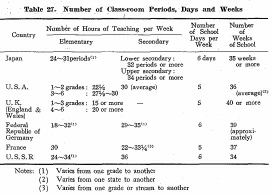
Elementary education
Table 28 presents the number and percentage of school hours allotted to each subject in the week in the sixth year of the primary level (fifth year for France). In the case of the U.S.A. and the United Kingdom (England and Wa1es), examples of one selected school are presented. This table shows that much time is always devoted to the mother tongue, followed, except for 2 cases, by arithmetic. Japan still devotes a comparatively low percentage of hours to the Japanese language, although it has increased the number of teaching hours in Japanese considerably in the revision of Course of Study made in 1958 by the Ministry of Education for the purpose of improving pupils' basic abilities. It is to be noted that in France individual written work also must be done at school--one hour each day--under the supervision of their school teachers, the memorizing of lessons being the only work done at home.
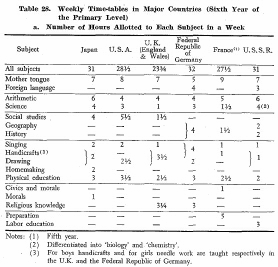
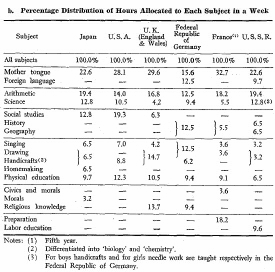
Secondary education
A comparison of the stress placed on each subject in the secondary schools of the advanced countries is made here separately for the lower stage and the upper stage.
The lower and upper stages correspond to the lower secondary schools and the upper secondary schools in Japan, respectively.
A major emphasis is placed on the study of the mother tongue in both stages in all countries. In the upper stage, Japan devotes a larger percentage to the mother tongue than any other country except the U.S.A.
The percentage of time devoted to the study of mathematics is lowest of all countries in the lower stage in Japan, but in the upper stage, Japanese is preceded only by the U.S.S.R., the modern stream of Lycee, in France, and the U.S.A.
The percentage of time devoted to both geography and history varies slightly from one country to another.
In tire field of science, physics, chemistry, and biology, Japan comes next to the U.S.S.R. in the lower stage, but in the upper stage, Japan devotes comparatively less time than the other countries. To foreign languages all the countries except the modern stream in France and the U.S.A. devote almost the same percentage of time in the lower stage. Highest percentages of time are devoted to foreign languages in lower secondary schools in the United Kingdom, the German Federal. Republic and France the least time in the U.S.A. and the U.S.S.R.
In the upper stage, however, the greatest percentages of time are given to foreign languages in the classical courses in the German Federal Republic and France, while the U.S.S.R. gives the least time to foreign languages.
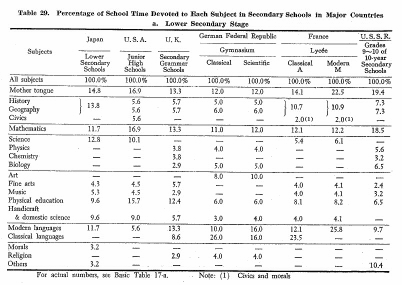
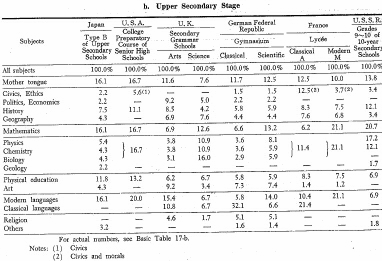
| Back to Top | MEXT HOME |